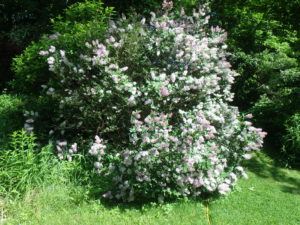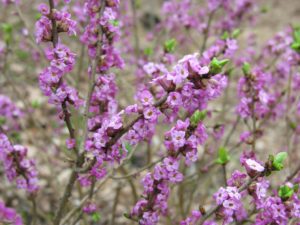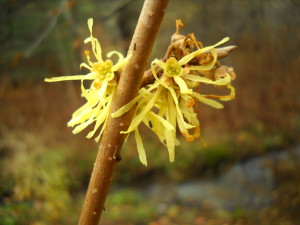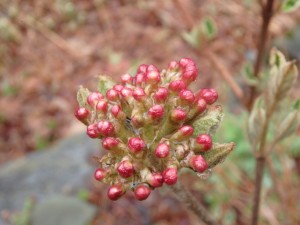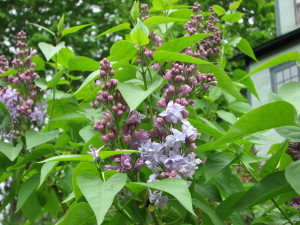A Dozen Sweet-Smelling Shrubs
Lilac season is about over. For the lasts two weeks I have been enjoying the amazing fragrance of ‘Miss Kim’, a species lilac (Syringa patula) with light purple blossoms. It was sold to me some 25 years ago as a dwarf lilac, but it is not. It’s just slow-growing. Mine is now 10 feet tall and wide. It was loaded with many hundreds of blossoms, and I was able to smell its fragrance from across the garden.
I have a gardening friend, Nelia Sargent of Claremont, NH, who specializes in fragrant plants. She is blind, so she cannot see their blossoms; she grows them, in part, because she loves their scent.
I called Nelia and asked for her list of fragrant shrubs. She told me that her goal is to have fragrance in her house and garden from spring until fall. “And I don’t want to have to put my nose in the flowers,” she said. “I want to smell them from 5 or 10 feet away, or even further.”
So she and I put together a list, roughly in sequence of bloom times. We agreed that even a shrub that should be fragrant, isn’t always sweet-smelling. So we recommend buying for fragrance when the plant is in bloom.
The earliest on Nelia’s list is a spring-blooming witchhazel (Hamamalis vernalis), one called ‘Arnold’s Promise’. It is hardy to Zone 4, but I have never grown it, but will. She has it and says it blooms in late winter. The frilly yellow blossoms are infused with red, and it is highly fragrant. She cuts blossoms and brings them in the house when snow is still on the ground, and they last in a vase for up to 2 weeks.
Next comes February daphne (Daphne mezereum). I’ve had this for over 15 years, and like it so much I named my little corgi after it. It has nice sweet pink blossoms that bloom in April. Mine rarely needs pruning and is still not 5 feet tall and wide. Mine was winter damaged this year for the first time ever. I like to cut stems in March and bring them in to bloom indoors.
Then come the Viburnums. Many are fragrant, some very fragrant. Three that Nelia likes are Viburnum judii, V. carlessii, and V. burkwoodii. Many viburnums are susceptible to the viburnum leaf beetle, which can defoliate a shrub in a week or less. Nelia told me she has not had a problem with those three. Birds love the berries viburnums produce.
A nice fragrant understory shrub that I grew up with in Connecticut is spicebush (Lindera benzoin). Its flowers are negligible, but its leaves are fragrant. I learned this as a boy, pulling off a leaf and noticing the strong scent. As a teenager I chewed on the twigs, using them as a breath freshener! I was able to find one for sale and have been growing it in dry shade for 3 years now.
Nelia mentioned fothergilla (Fothergilla major) as a fragrant shrub with a pleasing subtle scent. I’ve grown it for 20 years or so, and love it for the white, bottlebrush flowers in May and fabulous fall leaf color; but I have never noticed the fragrance. Mine might be the exception, and once again proves it important to buy things in bloom if you want fragrance.
All lilacs have nice fragrance in bloom, I think. Nelia was once asked to judge their scent for the Arnold Arboretum at Harvard. She determined that there are at least 20 different lilac fragrances in their collection. If you select early, mid-season and late-blooming lilacs, you can have 5 weeks of fragrance and blossoms, she said.
Nelia Sargent noted that the Japanese tree lilac (Syringa reticulata) is very fragrant, but that it should probably be considered an invasive and not planted. Seeds are spread by birds, and this stranger from a foreign land can out-compete many of our native understory plants. The gardeners at Saint Gaudens National Park have observed this, and actively remove them whenever they see them.
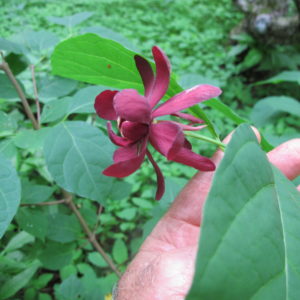 Carolina allspice or common sweetshrub (Calycanthus floridus) has been blooming for me since mid-June and has lovely deep wine-red flowers; it prefers a shady spot with rich moist soil. Although Nelia considers it fragrant, mine is not, or just barely. Still, a shrub that blooms in shade is always welcome in my gardens.
Carolina allspice or common sweetshrub (Calycanthus floridus) has been blooming for me since mid-June and has lovely deep wine-red flowers; it prefers a shady spot with rich moist soil. Although Nelia considers it fragrant, mine is not, or just barely. Still, a shrub that blooms in shade is always welcome in my gardens.
In August there is summersweet clethra (Clethra alnifolia). Nelia says a pink variety called ‘Ruby Spice’ is very fragrant. I have the wild white one, and it is fragrant, but not very.
In late August or early September the seven-son flower tree (Heptacodium miconioides) tree blooms. It is a very fast-growing tree – branches can grow 5 to 7 feet in a single season, but it slows down some when it reaches its full size of 25 feet tall or so. Mine has a pleasant, but not overpowering scent.It has wonderful exfoliating bark that is splendid in winter.
This list of fragrant shrubs cannot include them all. Mock orange, for one, is very strong smelling. Some rhododendrons are fragrant, particularly the native swamp azalea (Rhododendron viscosum). Please write me if you have a favorite I have neglected to mention. Perhaps I need to grow it!
Write Henry at henry.homeyer@comcast.net or P.O. Box 364, Cornish Flat, NH 03746. Please include a SASE if you wish a response by snail mail. Henry is the author of 4 gardening books.
Shrubs with Fragrant Flowers
Some gardeners grow flowers for their beauty in the garden. Others for their magnificence in a vase. A few select species largely for their scent. My friend Nelia Sargent of Claremont is in this third category, largely because she is blind. I called her recently to see what flowering shrubs she likes best.
Nelia loves shrubs because they pack so many flowers in a small space. And, unlike most perennial flowers, they have their blossoms close to nose level. Who needs to bend over to sniff a peony if you have old fashioned shrub roses standing up 3 or 4 feet tall? Here are some of her favorites along with a few of mine –roughly in sequence of their blossoms.
First for her, in late March or early April, is a witchhazel hybrid (Hamamelis x intermedia) called ‘Arnold’s Promise’. This flowers heavily with yellow strap-like petals an inch long originating at a reddish calyx cup. Although this bush can get large – up to 20 feet tall and wide, I have never seen one half that size, here in the North Country. I have our native witchhazel which blooms in late fall, but this hybrid is a great plant and one I should get. It’s very fragrant.
At the same time (or soon thereafter) is February Daphne, a tidy pink shrub that is very highly fragrant. I love this one so much I named my corgi after it. I’ve had mine for a dozen years and never had to prune it, which is a plus. I’ve seen it growing wild by the side of the road, which makes me wonder if it will be invasive sometime in the next 50 years. But since I’ve not gotten one seedling and it grows slowly, I’m not too worried.
Nelia Sargent then listed a number of viburnums that are fragrant and lovely. Three that she mentioned are Viburnum juddii, V. carlessii, and V. burkwoodii. Don’t be put off by the Latin names. Just pronounce the species names like juddii with an E-I sound at the end. All three species were named after horticulturists.
Viburnum juddii gets to be 6 to 8 feet tall tall, with blossoms about 3 inches across. V. carlessii, also called Koreanspice viburnum, gets to be 4 to 5 feet tall and wide, with 2 to 3 inch semi-snowball flowers. The Burkwood viburnum can get 8 to 10 feet tall with spread about 2/3’s its height; like the others, its flowers are pink in bud, opening to white and highly fragrant.
In recent years there has been an invasive beetle that has terrorized many viburnum owners. Cornell University has listed viburnums according to their susceptibility. Burkwood viburnum was listed as moderately susceptible to defoliation, but V. carlessiiand V. juddii were in the group least attractive to the beetle. You can see the entire list at http://www.hort.cornell.edu/
After the viburnums bloom, and overlapping with them, are the lilacs. Nelia Sargent noted that there are early, mid-season and late lilacs, so one can have fragrant lilacs for at least 5 weeks. First for her comes one called Sister Justina, a white one that stays tidy and does not send up root suckers. ‘Gertrude Lesley’, a double white is also early and nicely fragrant. The common lilac,Syringa vulgaris, has 800 or 900 named varieties. Most are mid-season and nicely fragrant. These spread by root, sending up suckers that will create a hedge if you are not attentive.
Fragrant late season lilacs include Miss Kim (a cultivar of Syringa patula), a slow-growing variety that is (mistakenly) sometimes called a miniature. Mine is now over 8 feet tall, definitely not a dwarf! Another late beauty is ‘Donald Wyman’ (Syringa x prestoniae ‘Donald Wyman’) which is hardy to Zone 2 (minus 50 Fahrenheit) and will thrive despite pollution and compaction in wet or dry soils! One tough plant.
The final shrub on Nelia’s list is mockorange (Philadelphus coronarius). Not related to oranges, this 10 to 12 foot shrub has white blossoms that are sweetly fragrant. That said, be advised that not all cultivars are fragrant, so buy one in bloom. It is an old fashioned flower and not particular to soil type.
Roses can be lovely and fragrant, but many of the modern hybrids have little or no scent. The Knockout roses are fabulous disease-resistant roses that bloom most of the summer, but I’ve only encountered one that was fragrant. On the other hand, rugosa roses are highly fragrant, as are many of the old fashioned roses. I recommend buying them when in bloom if fragrance is important.
I agree with Nelia Sargent: shrubs with fragrant blossoms are a good addition to the landscape. And they are often great for our native pollinators, too.
Read Henry’s garden blog at https://dailyuv.com/



